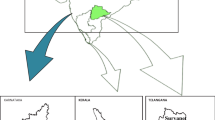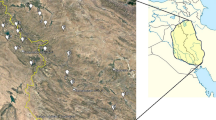Abstract
Ducrosia anethifolia Boiss is an aromatic vegetable and medicinal plant of Apiaceae family. In this study, morphological and essential oil studies as well as ISSR analyses were employed to investigate genetic diversity in 120 Moshgak accessions of 24 Iranian populations. High variations were observed in morpho-physiological traits (morphological and essential oil contents) of the populations in 2 consecutive agronomic years. In both studied years, the highest leaf (1% and 1.2%) and seed (2.46% and 2.9%) essential oil contents were recorded for the Abarkuh population. For ISSR analysis, 15 primer combinations were employed that produced 120 polymorphic bands. Dendrogram and STRUCTURE software grouped the accessions into four clusters although such grouping did not fit the geographic regions perfectly. Among the populations, Abarkuh and Kerman exhibited the highest genetic distance. Based on analysis of molecular variance (AMOVA), only 4.32% of the total genetic diversity was observed among the populations, while 95.68% was detected within the populations. Moreover, the studied populations exhibited a low genetic differentiation (Gst = 0.13) but a high gene flow (Nm = 3.26). It may be concluded that the results of the study provide new insights regarding the genetic diversity of Moshgak germplasm that will be useful for its conservation management and breeding programs for oil- and yield-related traits.






Similar content being viewed by others
Abbreviations
- ISSR:
-
Inter Simple Sequence Repeats
- CV:
-
Coefficient of variances
- ANOVA:
-
Analysis of variance
- PCoA:
-
Principal coordinate analysis
References
Ahmadi H, Rahimmalek M, Zeinali H (2014) Assessment of the genetic variation of chamomile (Matricaria chamomilla L.) populations using phytochemical, morphological and ISSR markers. Biochem Syst Ecol 54:190–197
Anderson J, Churchill G, Autrique J, Tanksley S, Sorrells M (1993) Optimizing parental selection for genetic linkage maps. Genome 36:181–186
Arabsalehi F, Rahimmalek M, Ehtemam MH (2018) Phytochemical and morphological variation of Stachys lavandulifolia Vahl. populations as affected by genotype × year interaction. Ind Crops Prod 112:342–352
Arbabi M, Naghdi Badi H, Labbafi M, Mehrafarin A, Saboki E (2018) Morphophysiological and phytochemical variability in some wild populations of Ducrosia anethifolia Boiss. from Iran. Chem Biodivers 15:301–323
Bahmani K, Izadi-Darbandi A, SadatNoori SA, Jafari A, Moradi N (2012) Determination of interrelationships among phenotypic traits of Iranian fennel (Foeniculum vulgare Mill.) using correlation, stepwise regression and path analyses. J Essent Oil Bear Plant 15:424–444
Excoffier L, Laval G, Schneider S (2005) Arlequin (version 3.0): an integrated software package for population genetics data analysis. Evol Bioinform 1:1–47
Fadaei Heidari E, Rahimmalek M, Mohammadi S, Ehtemam MH (2016) Genetic structure and diversity of ajowan (Trachyspermum ammi) populations based on molecular, morphological markers, and volatile oil content. Ind Crop Prod 92:186–196
Flores F, Moreno MT, Cubero JI (1998) A comparison of univariate and multivariate methods to analyze G × E interaction. Field Crop Res 56:271–286
Gaffney A, Allen G, Brown P (2011) Insect visitation to flowering hybrid carrot seed crops. N Z J Crop Hortic Sci 39:79–93
Gharibi S, Rahimmalek M, Mirlohi A, Majidi MM, Tabatabaei BES (2011) Assessment of genetic diversity in Achillea millefolium subsp. millefolium and Achillea millefolium subsp. elbursensis using morphological and ISSR markers. J Med Plant Res 5:2906–2916
Hashemifar Z, Rahimmalek M (2018) Genetic structure and variation in Perovskia abrotanoides and P. atriplicifolia as revealed by molecular and morphological markers. Sci Hortic 230:169–177
Hassanabadi M, Ebrahimi M, Farajpour M, Dejahang A (2019) Variation in essential oil components among Iranian Ferula assa-foetida L. accessions. Ind Crop Prod 140:598–604
Isshiki Sh, Iwata N, Khan MMR (2008) ISSR variations in eggplant (Solanum melongena L.) and related Solanum species. Sci Hortic 117:186–190
Jaccard P (1908) Nouvelles recherches sur la distribution florale. Bull Soc Vaud Sci Nat 44:223–270
Kapital B, Feyissa T, Petros Y, Mohammed S et al (2015) Molecular diversity study of black cumin (Nigella sativa L.) from Ethiopia as revealed by inter simple sequence repeat (ISSR) markers. Afr J Biotechnol 14:1543–1551
Karami A, Bohlooli A (2017) Essential oil chemical diversity of Ducrosia anethifolia (DC.) Boiss. accessions from Iran. J Essent Oil Bear Plant 5:1342–1348
Lal RK (2008) Stability and genotypes × environment interactions in fennel. J Herbs Spices Med Plants 13:47–54
Liang S, Jie CH, Kai X, Wencai Y (2017) Origin of the domesticated horticultural species and molecular bases of fruit shape and size changes during the domestication, taking tomato as an example. Hortic Plant J 3:125–132
Maghsoudi Kelardashti M, Rahimmalek M, Talebi M (2015) Genetic diversity in Iranian fennel (Foeniculum vulgare Mill.) populations based on sequence related amplified polymorphism (SRAP) markers. J Agric Sci Technol 17:1789–1803
Mantel N (1967) The detection of disease clustering and a generalized regression approach. Cancer Res 27:209–220
Martinez L, Cavagnaro P, Masuelli R (2003) Evaluation of diversity among Argentine grapevine (Vitis vinifera L.) varieties using morphological data and AFLP markers. Electron J Biotechnol 6:37–45
Mostafavi A, Afzali D, Mirtadzadini SM (2008) Chemical composition of the essential oil of Ducrosia anethifolia (DC.) Boiss. from Kerman Province in Iran. J Essent Oil Res 20:509–512
Muhaidat R, Brake MH, Al Zoubi M et al (2018) Integrating morphological characters, molecular markers, and distribution patterns to assess the identity of Blepharis species from Jordan. Bot Stud 59:18
Nei M, Li H (1979) Mathematical model for studying genetic variation in terms of restriction endonucleases. Proc Natl Acad Sci USA 76:5269–5273
Pirkhezri M, Hassani ME, Hadian J (2010) Genetic diversity in different populations of Matricaria chamomilla L. growing in southwest of Iran, based on morphological and RAPD Markers. J Med Plant Res 4:1–13
Pritchard JK, Wen W (2003) Documentation for STRUCTURE software: version 2. Available from http://pritch.bsd.uchicago.edu
Rahimmalek M, Bahreininejad B, Khorrami M, Sayed Tabatabaaei BE (2009) Genetic variability and geographic differentiation in Thymus daenensis an endangered medicinal plant, as revealed by inter simple sequence repeat (ISSR). Biochem Genet 47:831–842
Rohlf F (1998) NTSYS-pc version 2 0. Numerical taxonomy and multivariate analysis system. Exeter Software Setauket, New York
Sabbaghi Rahimi B, Rahimmalek M (2019) Genetic structure and variation of Moshgak (Ducrosia anethifolia Boiss.) populations based on morphological and molecular markers. Sci Hortic 257:668–676
Sarfaraz D, Rahimmalek M, Saeidi G, Sabzalian MR (2020) Genetic relations among and within wild and cultivated Thymus species based on morphological and molecular markers. 3 Biotech 10:289
Sarfaraz D, Rahimmalek M, Saeidi G (2021) Polyphenolic and molecular variation in Thymus species using HPLC and SRAP analyses. Sci Rep 11:5019
SAS Institute (2001) User’s guide. Release 9.2. SAS Institute, Cary, pp 225–293
Shahabipour S, Firuzi O, Asadollahi M, Faghihmirzaei E, Javidnia K (2013) Essential oil composition and cytotoxic activity of Ducrosia anethifolia and Ducrosia flabellifolia from Iran. J Essent Oil Res 25:160–163
Shojaiefar S, Mirlohi A, Sabzalian MR, Yaghini H (2015) Seed yield and essential oil content of fennel influenced by genetic variation and genotype × year interaction. Ind Crops Prod 71:97–105
Soleimani MH, Talebi M, Sayed Tabatabaei BE (2012) Use of SRAP markers to assess genetic diversity and population structure of wild cultivated and ornamental pomegranates (Punica granatum L.) in different regions of Iran. Plant Syst Evol 298:1141–1149
Solouki M, Mehdikhani H, Zeinali H, Emamjomeh A (2008) Study of genetic diversity in Chamomile (Matricaria chamomilla) based on morphological traits and molecular markers. Sci Hortic 117:281–287
Statgraphics (2016) Statgraphics. Version 17.2.1. Stat Point Inc., Warrenton
Tohidi B, Rahimmalek M, Arzani A (2017) Essential oil composition, total phenolic, flavonoid contents, and antioxidant activity of Thymus species collected from different regions of Iran. Food Chem 220:153–161
Verma KS, ul Haq S, Kachhwaha S, Kothari SL (2017) RAPD and ISSR marker assessment of genetic diversity in Citrullus colocynthis (L.) Schrad: a unique source of germplasm highly adapted to drought and high-temperature stress. 3 Biotech 7:288
Yan W, Hunt LA (1998) Genotype by environment interaction and crop yield. Plant Breed Rev 16:135–178
Yan W, Kang MS (2003) GGE biplot analysis: a graphical tool for breeders, geneticists, and agronomists. CRC Press, Boca Raton, p 280
Acknowledgements
We would like to thank Mr. Amir Barzegar for germplasm support and Isfahan University of Technology for financial support.
Funding
The article was supported by Isfahan University of Technology and there are no competing financial interests or personal relationships that could have appeared to influence the work reported in this paper.
Author information
Authors and Affiliations
Corresponding author
Ethics declarations
Conflict of interest
The authors declare that they have no known competing financial interests or personal relationships that could have appeared to influence the work reported in this paper.
Additional information
Publisher's Note
Springer Nature remains neutral with regard to jurisdictional claims in published maps and institutional affiliations.
Supplementary Information
Below is the link to the electronic supplementary material.
10528_2022_10237_MOESM1_ESM.docx
Supplementary file1 (DOCX 87 kb)—Figure S1. ISSR marker profiles of Moshgak accessions generated by P13 ISSR primer. M: 50 bp ladder.
10528_2022_10237_MOESM2_ESM.docx
Supplementary file2 (DOCX 24 kb)—Figure S2. Estimation of Delta K as a prerequisite for the best fit value of K obtained with STRUCTURE analysis.
Rights and permissions
About this article
Cite this article
Arabsalehi, F., Rahimmalek, M. & Sabzalian, M.R. Morpho-Physiological and Molecular Characterization Reveal Low Genetic Variation for Conservation of Endangered Iranian Moshgak (Ducrosia anethifolia Boiss). Biochem Genet 60, 2587–2610 (2022). https://doi.org/10.1007/s10528-022-10237-0
Received:
Accepted:
Published:
Issue Date:
DOI: https://doi.org/10.1007/s10528-022-10237-0




